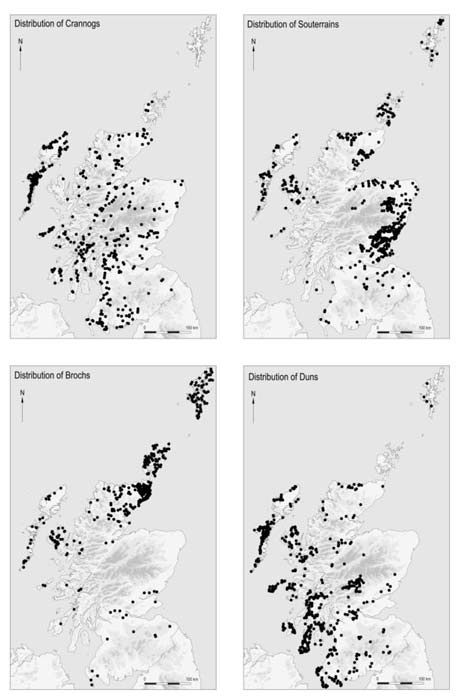
Advanced Scottish Culture Stopped Romans Taking All Of Britannia
New archaeological evidence demonstrates that Britain’s Hadrian’s Wall was not a cause, but instead an effect of the cultural differences that already thrived between the two territories that would later become Scotland and England.
Since the time of the 1st century Roman invasion of Britain, an incorrect stereotype maintains that ancient Scottish cultures were barbaric, and hyper-violent, more so than strategists and tacticians in items of war. However, all archaeological evidence suggests that Iron Age cultures to the north of the modern Scotland/England border were relatively more advanced, culturally, than all surrounding Iron Age cultures in Europe.
Now, a new study of the distribution patterns of ancient settlement types in northern Britain reasserts this emerging picture, that prehistoric cultures in Scotland lived free of the social chaos and tribal warfare that made ancient England and France relatively easy for the Romans to take.
- Britain’s “Best Preserved Pictish Homes” Studied in Caithness
- Botanical Mystery of the Ancient Ulbster Stone

Hadrian built a wall to split Roman Britannia and defend the end of the empire. (andy/ Adobe Stock)
The Romans Only Delineated Existing Cultural Differences
Hadrian's Wall, or ‘Vallum Hadriani’ in Latin, was a defensive fortification that split the Roman province of Britannia in two. With the first stones having been laid in 122 AD, in the reign of the emperor Hadrian, the wall extends 73 miles (117.5 kilometers) across what is today northern England. The crumbling historic structure was designated as a UNESCO World Heritage Site in 1987.
Traditionally, archaeologists and historians thought of the Romans as having been the first to divide ancient Britain, and that the wall caused the differences that led to the later clashes between the two individuated cultures. However, the newly published research shows that peoples of early Scotland and England ‘were already culturally divergent,’ long before Hadrian split the terrain.
Changes In Latitudes, Changes In Attitudes
Professor Ronan Toolis from GUARD Archaeology published his new study ‘ Shifting perspectives on 1st-millennia Scotland,’ in the Proceedings of the Society of Antiquaries of Scotland. The researcher identified ‘cultural divergence’ between the north and south of Britain in prehistory, existing long before the Romans arrived. Furthermore, these differences amplified and still existed beyond the medieval period, according to Dr Toolis.
Between the 4th-2nd centuries BC, ancient structures including brochs, duns, crannogs and souterrains were built, and Toolis plotted them all from the north of modern-day Scotland to the north of England. This is when he noted ‘great cultural differences’ in those living north and south of the Tweed–Solway zone before the Romans physically divided the territory with their wall.
- Adidas of Ancient Rome: Ancient Fashion Unveiled with Discovery of Roman Shoe Hoard
- Ancient Butter Dish Found in Scottish Lake Still Held Butter

Distribution maps of crannogs, souterrains, brochs and duns © GUARD Archaeology Ltd
Hadrian Vs Iron Age Scotland
Having destroyed indigenous fighting forces in Achaea (Greece), Judea (Middle East) and the North African coastal region, Romans swept across Hispania (Spain) Gallia (France) and formed the Roman province of Britannia after conquering England and Wales. The Romans defeated all of these kingdoms because of their weak unorganized tribal structures, especially in England, but the new study suggests the Roman’s failure to take Scotland is perhaps more to do with the ‘nature of Iron Age society in Scotland’.
It is speculated that early broch clusters in lowland Scotland represent ‘an Iron Age precursor to the pre-eminent households that emerged in the 5th–7th centuries AD’. Dr Toolis thinks these broch clusters reflect how Iron Age Scotland was ‘replicating a process of households accruing power and status that had been arrested in development, either because of Roman aggression or internal social upheaval, during the early centuries AD’.
National Identity Is A Hard Shell To Crack
Some of the people groups of early Scotland identified as Britons, while others followed the customs of Picts or the Scots, but all three shared cultural traits unique to what is today Scotland, and not with more tribal cultures to the south. And while northern cultures differed from those to the south of Britain, so too did they differ from each other, but what seems to have existed from at least the 2nd century is a strong sense of national identity, something that is still very present in most Scots today.
Top image: Broch of Dun Carloway, Isle of Lewis, Scotland. Source: Manel Vinuesa / Adobe Stock
By Ashley Cowie
















Comments
I don't think there's any doubt late Iron Age northern Britain was less fractious than the south.
Partly this may have stemmed from geography, but equally from culture too. The Picts, for example, were a strong, unifying factor along most of the north-east coast during the occupation of the south.
The Romans were masters at divide and conquer and Caledonia was clearly awake to what happened in Gaul. When the legions arrived in Kent the Caledonians would have known about it and appear to have been prepared. Being far to the north of the landing site was obviously an advantage in that regard. The Northern Isles, in particular, were a stronghold, until the Norse took them centuries later, and this would have given some security to the resistance, as did the mountainous terrain of the Highlands.
There's also the possibility that alliances on the west may have been forged with Ulster in particular and perhaps even Hibernia in general. The usual story is that Gaelic culture arrived after Roman Britain, however the roots of this event may be deeper than that. The Romans may have been the catalyst.